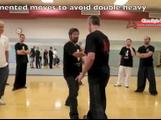–I missed a good deal today, especially right after lunch, but these are the notes I took–
Foundation practice and Yilu are to warm up the body. The body must be separated into Yin and Yang, structure and action. The body has to completely lock up with the exception of one piece. Then an action has to move that one piece. The action has to be outside the body, but it’s also in the body. It’s like a hand with a powerful grip on a screwdriver. The hand is not part of the screwdriver, but it is part of the screwdriver. All the action comes from the hand, none from the screwdriver. But they move as one.
We have to learn to get a hold on a line. Ignore the arm or whatever it is and just get a hold on the line. A hold requires being on both sides of the line. Scissors are designed to get a hold, to get on both sides, of something as thin as paper.
The power used to throw a cotton ball at someone is the same as the power used to throw a stone at someone. The difference is the cotton ball absorbs that power on impact, while the stone transfers that power to the person it hits on impact.
To deal with a solid object, use a stick. To deal with an object that’s not solid, use a bow and arrow. These two structures can be seen all throughout the world. They are fundamental.
The highest level of fighting is when someone adds the third dot to a line and finishes the opponent’s move for them. Taiji is unclear in a way that is clear. The three dots are totally independent and unrelated to each other, but they must happen at the same time. It is as though a professor is teaching a large class, and everyone is listening and paying attention at the same time, but they are listening and paying attention independent from each other. Our movements are completely separate from each other, but the opponent feels one move. A qun (large mythical bird) and a gnat cannot understand each other, the qun lives for millions of years, the gnat from 9:00 AM to 3:00 PM. And yet, their stories are the same: birth, growth, sex, reproduction, decay, death. They cannot relate, but it’s exactly the same. Taiji is everything put together by one thing: time



